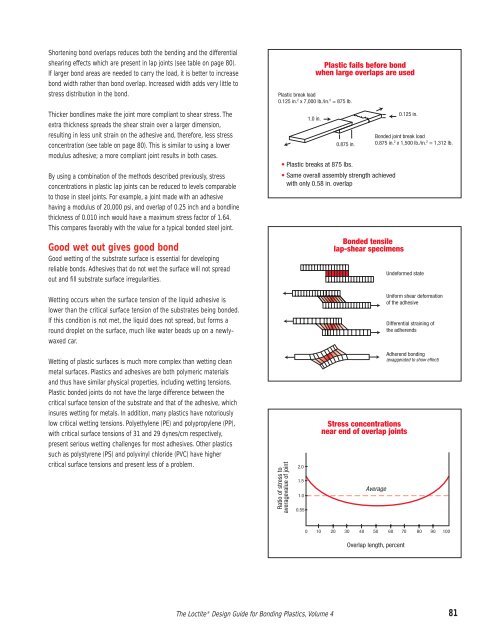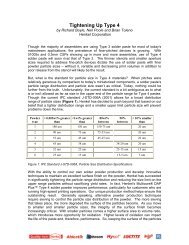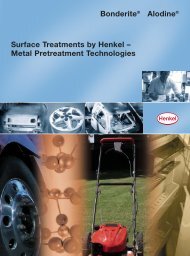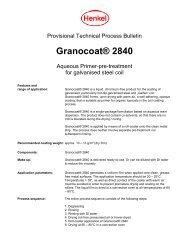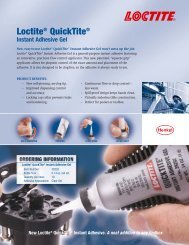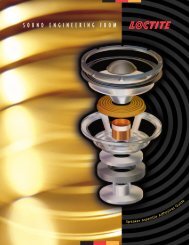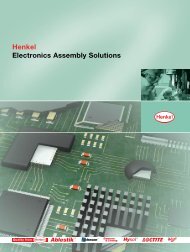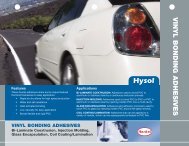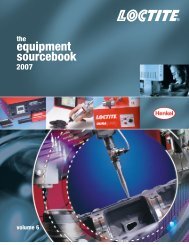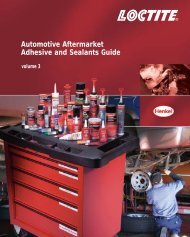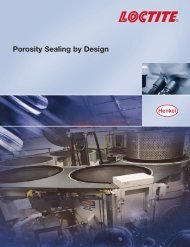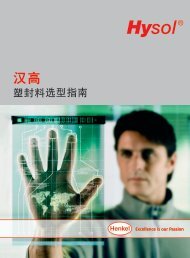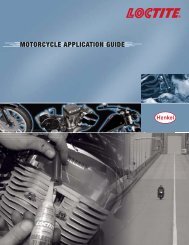Processor Rules for Good Adhesive AssemblyRichard Thompson, Senior Product Engineer (Retired)There’s more to reliable adhesive assemblythan picking the right adhesive. Processorswith assembly operations will boost theirquality batting average by understanding allthe ground rules.Today’s new and better plastic materials offer plastic-parts assemblersmany opportunities to produce more reliable and durable products,often at lower cost. These new materials call for techniques that differgreatly from those used with traditional materials.Assemblers must understand that plastics, compared to traditionalmaterials, such as metals, have lower tensile strength, are usually moreflexible, have higher coefficients of expansion, and often are harder toadhere to. These differences greatly influence the way joints aredesigned and adhesives are selected.Why plastic fails before jointThe lower tensile strengths of plastics make it common to createbonded joints that are stronger than the plastic itself. Consider a jointbetween two strips of plastic 1 inch wide x 1 ⁄8 inch thick, as illustratedon page 81. Because of the large joint overlap, the substrate will failbefore the bond. The same overall assembly strength could be achievedwith an overlap of only 0.58 inch.Flex modulus stresses jointsWith an elastic modulus of about 300,000 psi, a typical unreinforcedplastic part is over 100 times more flexible than steel for identicallyshaped components. In designing lap joints, this added flexibility meansthat more bending and differential shearing will occur in the bondedjoint as the assembly is placed under load.This flexibility leads to increased stress concentration near the ends ofthe overlap. However, the stress ratios of plastic overlap joints are fargreater than those of steel joints (see table below). Theseconcentrations can lead to joint failure at relatively low loads.The disadvantages of these high stress concentrations can be reducedeffectively in many cases by careful selection of the other joint designparameters. Most important among these are: the elastic modulus ofthe adhesive, length of the overlap, and thickness of the bondlinebetween the two substrates (see drawing on page 81).A lower modulus adhesive reduces stress concentrations byaccommodating the relative motion of the two substrates with greatershear compliance (see table below). The extreme case is when arubbery adhesive is used. Such an adhesive is so flexible that sheardeformations can be accommodated without creating significant stressconcentrations. But an adhesive this flexible may not be able toaccommodate the structural loads on an actual assembly withoutexcessive deformation.This situation shows why adhesive manufacturers often report“substrate failure” in a table of bonding strengths on plastics. Most ofthe standard test methods were originally designed for metals and haveno instructions for adjusting the bond area used according to the tensilestrength of the material.Effects of Bondline GapBondline Gap (Inches) Stress Ratio (Maximum)0.001 18.400.002 13.000.005 8.310.010 5.930.020 4.250.040 3.06Effects of Substrate ModulusMaterial Modulus psi Stress RatioSteelGlass-filledPlasticUnfilled30,7000,000 1.691,000,000 7.77Plastic 300,000 13.03Effects of Joint OverlapOverlap Length (Inches) Stress Ratio (Maximum)1.000 22.500.500 13.000.250 7.170.125 3.78Effects of Adhesive ModulusAdhesive Modulus (psi) Stress Ratio (Maximum)300,000 22.40100,000 13.0350,000 9.2720,000 5.93200 1.13Constants for TablesAdhesive Modulus = 100,000 psiOverlap= 0.5 in.Bondline= 0.002 in.Load= 100 lbs.Substrate Thickness = 0.125 in.Substrate Modulus = 300,000 psi80The <strong>Loctite</strong> ® Design Guide for Bonding Plastics, <strong>Volume</strong> 4
Shortening bond overlaps reduces both the bending and the differentialshearing effects which are present in lap joints (see table on page 80).If larger bond areas are needed to carry the load, it is better to increasebond width rather than bond overlap. Increased width adds very little tostress distribution in the bond.Thicker bondlines make the joint more compliant to shear stress. Theextra thickness spreads the shear strain over a larger dimension,resulting in less unit strain on the adhesive and, therefore, less stressconcentration (see table on page 80). This is similar to using a lowermodulus adhesive; a more compliant joint results in both cases.By using a combination of the methods described previously, stressconcentrations in plastic lap joints can be reduced to levels comparableto those in steel joints. For example, a joint made with an adhesivehaving a modulus of 20,000 psi, and overlap of 0.25 inch and a bondlinethickness of 0.010 inch would have a maximum stress factor of 1.64.This compares favorably with the value for a typical bonded steel joint.Good wet out gives good bondGood wetting of the substrate surface is essential for developingreliable bonds. Adhesives that do not wet the surface will not spreadout and fill substrate surface irregularities.Wetting occurs when the surface tension of the liquid adhesive islower than the critical surface tension of the substrates being bonded.If this condition is not met, the liquid does not spread, but forms around droplet on the surface, much like water beads up on a newlywaxedcar.Wetting of plastic surfaces is much more complex than wetting cleanmetal surfaces. Plastics and adhesives are both polymeric materialsand thus have similar <strong>ph</strong>ysical properties, including wetting tensions.Plastic bonded joints do not have the large difference between thecritical surface tension of the substrate and that of the adhesive, whichinsures wetting for metals. In addition, many plastics have notoriouslylow critical wetting tensions. Polyethylene (PE) and polypropylene (PP),with critical surface tensions of 31 and 29 dynes/cm respectively,present serious wetting challenges for most adhesives. Other plasticssuch as polystyrene (PS) and polyvinyl chloride (PVC) have highercritical surface tensions and present less of a problem.The <strong>Loctite</strong> ® Design Guide for Bonding Plastics, <strong>Volume</strong> 4 81


